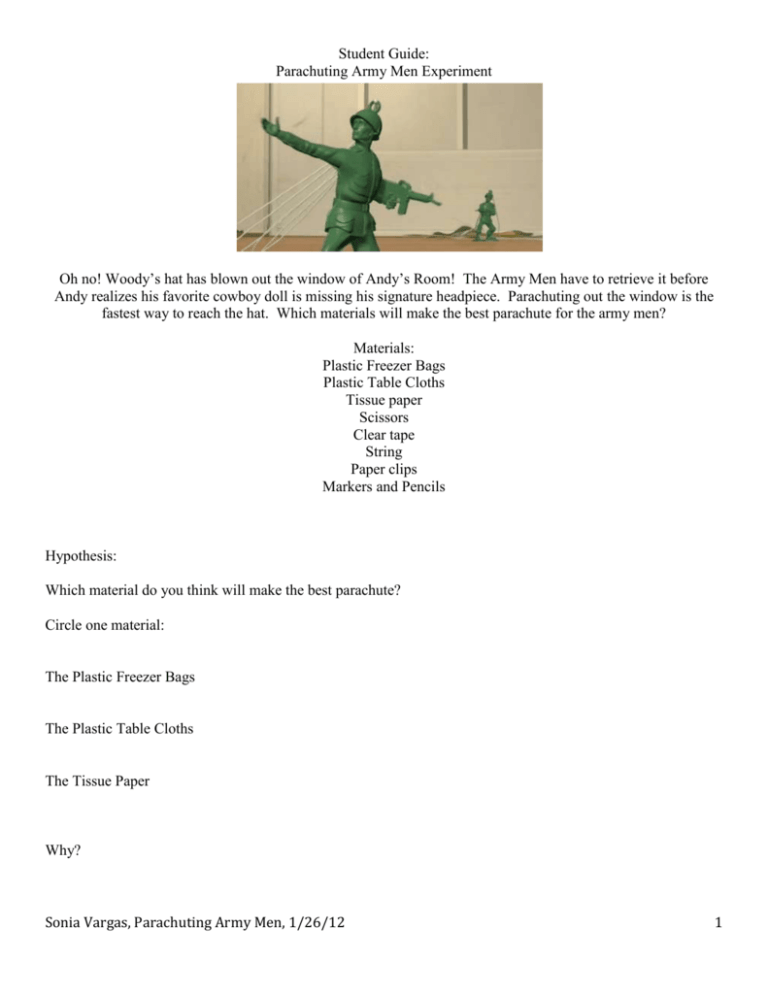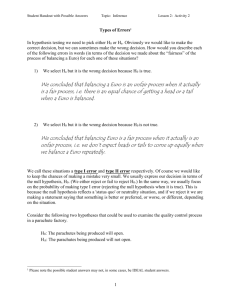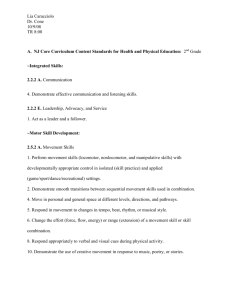Parachuting Army Men Experiment
advertisement

Student Guide: Parachuting Army Men Experiment Oh no! Woody’s hat has blown out the window of Andy’s Room! The Army Men have to retrieve it before Andy realizes his favorite cowboy doll is missing his signature headpiece. Parachuting out the window is the fastest way to reach the hat. Which materials will make the best parachute for the army men? Materials: Plastic Freezer Bags Plastic Table Cloths Tissue paper Scissors Clear tape String Paper clips Markers and Pencils Hypothesis: Which material do you think will make the best parachute? Circle one material: The Plastic Freezer Bags The Plastic Table Cloths The Tissue Paper Why? Sonia Vargas, Parachuting Army Men, 1/26/12 1 3rd Grade Procedure: 1. 2. 3. 4. On your material, trace a 8 by 8 inch square using a stencil with a marker. Cut out the square with scissors. Take the string, and measure and cut four 6-inch strings. Use clear tape to attach one string to each of the four corners of your parachute. Make sure you tape them all on the same side. 5. Take the four strings of your parachute and tie them together with a knot or wrap tape around them (like a shoelace). 6. Make sure the taped edges of the string are attached to the outside of the parachute. (If not, retie the knot.) 7. Attach a paperclip to the knot or tape with more tape. You should be in a group with two other people who have parachutes made of different materials than your parachute. In your group you should have three parachutes: one made of tissue paper, one made of plastic table cloth, and one made of plastic freezer bags. To test the parachutes, stand up, hold your parachute out in front of you, and quickly drop it. Practice the best way to drop your parachutes with your group. Now repeat the process with your partner(s): Drop all three parachutes at the same time. Make sure that you’re all dropping your parachutes from the same height. Have one person count down from three so you can all drop your parachutes at the same time. Record which parachute fell the slowest in your data table. Compare how many times each parachute touched the ground last. The parachute that fell the slowest the most times is the best parachute. Trial 1 Which parachute touched the ground last? Trial 2 Which parachute touched the ground last? Trial 3 Which parachute touched the ground last? Trial 4 Which parachute touched the ground last? Which material did you think would work better for a parachute? Were you right? Which material worked the best, and why do you think that is? Sonia Vargas, Parachuting Army Men, 1/26/12 2 4th Grade Procedure: 1. 2. 3. 4. On your material, trace a 8 by 8 inch square using a stencil with a marker. Cut out the square with scissors. Take the string, and measure and cut four 6-inch strings. Use clear tape to attach one string to each of the four corners of your parachute. Make sure you tape them all on the same side. 5. Take the four strings of your parachute and tie them together with a knot or wrap tape around them (like a shoelace). 6. Make sure the taped edges of the string are attached to the outside of the parachute. (If not, retie the knot.) 7. Attach a paperclip to the knot or tape with more tape. Experiment 1: You should be in a group with two other people who have parachutes made of different materials than your parachute. In your group you should have three parachutes: one made of tissue paper, one made of plastic table cloth, and one made of plastic freezer bags. To test the parachutes, stand up, hold your parachute out in front of you, and quickly drop it. Practice the best way to drop your parachutes with your group. Now repeat the process with your partner(s): Drop all three parachutes at the same time. Make sure that you’re all dropping your parachutes from the same height. Have one person count down from three so you can all drop your parachutes at the same time. Record which parachute fell the slowest in your data table. Compare how many times each parachute touched the ground last. The parachute that fell the slowest the most times is the best parachute. Trial 1 Which parachute touched the ground last? Trial 2 Which parachute touched the ground last? Trial 3 Which parachute touched the ground last? Trial 4 Which parachute touched the ground last? Which material did you think would work better for a parachute? Were you right? Which material worked the best, and why do you think that is? Sonia Vargas, Parachuting Army Men, 1/26/12 3 Now that we know what material works the best for parachutes, let’s see what kind of cord material works best. Each member of your group will repeat the procedure for making parachutes with the material that worked the best in Experiment 1. For Experiment 2, each member of your group will use a different type of strings instead of a different type of parachute material. Experiment 2: Which type of string do you think will work better? Circle your answer: Embroidery Thread Cotton Twine Yarn Why? To test the parachutes, stand up, hold your parachute out in front of you, and quickly drop it. Practice the best way to drop your parachutes with your group. Now repeat the process with your partner(s): Drop all three parachutes at the same time. Make sure that you’re all dropping your parachutes from the same height. Have one person count down from three so you can all drop your parachutes at the same time. Record which parachute fell the slowest in your data table. Compare how many times each parachute touched the ground last. The parachute that fell the slowest the most times is the best parachute. Trial 1 Which parachute touched the ground last? Trial 2 Which parachute touched the ground last? Trial 3 Which parachute touched the ground last? Trial 4 Which parachute touched the ground last? Which string type worked the best for the parachute? Were you right? Now you have the best parachute for the Army Men! Great job! Sonia Vargas, Parachuting Army Men, 1/26/12 4 5th-6th Grade Procedure: 1. On your material, trace a 8 by 8 inch square using a stencil with a marker. 2. Cut out the square with scissors. 3. Take the string, and measure and cut four 6-inch strings. 4. Use clear tape to attach one string to each of the four corners of your parachute. Make sure you tape them all on the same side. 5. Take the four strings of your parachute and tie them together with a knot or wrap tape around them (like a shoelace). 6. Make sure the taped edges of the string are attached to the outside of the parachute. (If not, retie the knot.) 7. Attach a paperclip to the knot or tape with more tape. In your group you should have three parachutes: one made of tissue paper, one made of plastic table cloth, and one made of plastic freezer bags. Experiment 1: To test the parachutes, stand up, hold your parachute out in front of you, and quickly drop it. Practice the best way to drop your parachutes with your group. Now repeat the process with your partner(s): Drop all three parachutes one at a time and time them with a stopwatch. Make sure that you’re dropping all your parachutes from the same height. You can use a meter stick if you want to make sure that you’re dropping them from the same height each time. Have one person count drop them, one person time them, and one person record. Make sure to record which parachute fell the slowest in your data table. For one parachute, add all the trial times up, and then divide the sum by 4. This will give you an average time for that parachute. The parachute that has the largest average time wins. Data Table: Trial 1 Trial 2 Trial 3 Trial 4 What are the average times? (In seconds) Freezer Bag Parachute Plastic Table Cloth Parachute Tissue Paper Parachute Which material did you think would work better for a parachute? Were you right? Which material worked the best, and why do you think that is? Sonia Vargas, Parachuting Army Men, 1/26/12 5 Now that we know what material works the best for parachutes, let’s see what kind of cord material works best. Each member of your group will repeat the procedure for making parachutes with the material that worked the best in Experiment 1. For Experiment 2, each member of your group will use a different type of strings instead of a different type of parachute material. Which type of string do you think will work better? Circle your answer: Embroidery Thread Cotton Twine Yarn Why? Experiment 2: To test the parachutes, stand up, hold your parachute out in front of you, and quickly drop it. Practice the best way to drop your parachutes with your group. Now repeat the process with your partner(s): Drop all three parachutes one at a time and time them with a stopwatch. Make sure that you’re dropping all your parachutes from the same height. You can use a meter stick if you want to make sure that you’re dropping them from the same height each time. Have one person in your group drop them, one person time them, and one person record. Make sure to record which parachute fell the slowest in your data table. For one parachute, add all the trial times up, and then divide the sum by 4. This will give you an average time for that parachute. The parachute that has the largest average time wins. Data Table: Trial 1 Trial 2 Trial 3 Trial 4 What are the average times? (In seconds) Yarn Parachute Embroidery Thread Parachute Cotton twine Parachute Which string type worked the best for the parachute? Were you right? Now you have the best parachute for the Army Men! Great job! Sonia Vargas, Parachuting Army Men, 1/26/12 6 *Let’s try adding weight: Using the parachutes from Experiment 1, we will add more weight and see if the parachute that performed the best continues to perform the best. Trial 1 Two paperclips Which parachute touched the ground last? Trial 2 Three paperclips Which parachute touched the ground last? Trial 3 Four paperclips Which parachute touched the ground last? Trial 4 Five paperclips Which parachute touched the ground last? Using the parachutes from Experiment 2, we will add more weight and see if the parachute that performed the best continues to perform the best. Trial 1 Two paperclips Which parachute touched the ground last? Trial 2 Three paperclips Which parachute touched the ground last? Trial 3 Four paperclips Which parachute touched the ground last? Trial 4 Five paperclips Which parachute touched the ground last? What was the best combination of weight, string, and material? Now you have the best parachute for the Army Men! Great job! Sonia Vargas, Parachuting Army Men, 1/26/12 7 Teacher’s Guide: Parachuting Army Men by Sonia Vargas, Colby College, January 2012 Teaching Objectives: To introduce the basic physical concepts of air resistance and gravity Time Allotment: This experiment takes about 30-40 minutes, depending on the speed your students work through the experiments. . Key Terms: Gravity- a force that attracts all objects to all other objects Air resistance- drag that acts on things falling through air. Free Fall- when an object falls without significant air resistance. Newton’s Second Law- the acceleration of an object as produced by a net force is directly proportional to the magnitude of the net force, in the same direction as the net force, and inversely proportional to the mass of the object. Theme: Toy Story Oh no! Woody’s hat has blown out the window of Andy’s Room! The Army Men have to retrieve it before Andy realizes his favorite cowboy doll is missing his signature headpiece. Parachuting out the window is the fastest way to reach the hat. Which materials will make the best parachute for the army men? Applications: Gravity is a force that is constantly acting on everything on this Earth. Parachutes are used in real life, and are a good example of Newton’s second law. This activity can be used as gateway to Newton’s laws of motion. Total Materials (for a class of 21): 1. Plastic table clothes. One tablecloth should be enough for the whole class, but if you want different colors, you can buy more. 2. Gallon sized freezer bags (plastic bags). 1 box will be enough for the whole class. 3. One package of tissue paper, the kind used for wrapping presents. If you want more colors you can buy more. 4. One box of paperclips, the large ones. 5. Clear tape dispensers. 7 dispensers, one for each group. 6. Yarn 7. Embroidery thread 8. Cotton twine/hemp 9. Markers and Sharpies 10. Scissors, 21 pairs. 11. 21 rulers Setup: Separate students into 7 groups of three. Each student will need: 1. One ruler 2. One pair of scissors Each group will need: 1. One sheet of each material, (the tissue paper, the plastic table cloth, and the freezer bags). 2. 1 long strands of each cord material, (the yarn, thread, and twine). Sonia Vargas, Parachuting Army Men, 1/26/12 8 3. 3 more long strands of the twine. 4. 3 large paperclips 5. Markers and sharpies, at least one marker and two sharpies per group. There can be more if they are in your budget. 6. One tape dispenser. 7. 3 stencils (or they can share stencils). You can do this while the kids are outside the classroom at lunch or recess. Cut the tissue paper, plastic bags and the plastic tablecloths into sheets for the kids to use, (the table cloths will need to be cut down into smaller sections). Cut along the seams of the bags and make them into continuous sheets. To make sure that each student in the group is making a parachute with a different material, number the students off and assign them to groups like so: Students with the number “one” will make parachutes with the plastic bags, students with the number “two” will make parachutes with the plastic table cloths, and students with the number “three” will make the tissue paper parachutes. Those three students are one group. Using poster paper or cardboard, make 8 by 8 inch squares and cut them out. The kids will use these as stencils. Make as many as you need for your class. They can share stencils if they are in groups. Put markers out on the desks for the kids to use. They can share markers in their groups. The color does not matter. If you want to have the kids measure the string out, have them measure the string with a ruler and cut it. Each parachute needs 4 pieces of a 6-inch string. You can pre-cut the string to make the experiment go by faster. If you’re having the students measure the string themselves, make sure they have a ruler in their group. They can share rulers if they are in groups. Give each group a clear-tape dispenser, or pre-cut pieces of tape and tape them to the edge of the table for easier access for younger students. In-Class Demos: Materials: Two coffee filters A small rock Take the rock and let it fall out of your hand and drop to the ground. Ask the class why it falls downward even though you didn’t throw it. * According to Isaac Newton, gravity is a force that attracts all objects to all other objects. Earth exerts such a huge force of gravity that we are all attracted to it. The reason the rock falls to the Earth is because it is attracted there by the Earth’s force of gravity. Explain that gravity is the reason we’re all standing on the ground and not floating into space. When someone is on the moon, there isn’t as much gravity as there is on Earth, and that is why people will float there. Use two identical coffee filters. Keep one as a regular coffee filter (flatten it out a little), and crumple the other into a ball. Ask the class which one will fall faster. Sonia Vargas, Parachuting Army Men, 1/26/12 9 *The crumpled up piece of paper will fall faster. The regular piece of paper has more surface area and will allow for more air molecules to hit against it and to slow it down. The regular sheet attracts more air resistance because of its larger surface area. Parachutes give a person more surface area, and therefore attract more air resistance. This allows for a slower and safer decent when falling from a high height. Take the rock and the crumpled up coffee filter. Crumple the coffee filter up until it’s about the same size as the rock. Ask the class which one will fall faster, the rock or the filter. *They fall at the same rate because they have about the same surface area, so they both have about the same amount of air resistance acting on them. It does not matter that the rock has more mass than the paper. If the rock and the paper were on the moon, they would fall at the same rate despite if you crumpled the paper or not, because of the lack of air resistance and the pull of the moon’s force of gravity. Procedure: Please see the attached student handout for the directions to make the parachutes. The “Let’s add weight” sheet is optional. If you want a longer experiment, you can add that sheet into the 4th or 5th grade version. Use page one as a coversheet for all versions of this experiment. Sonia Vargas, Parachuting Army Men, 1/26/12 10







